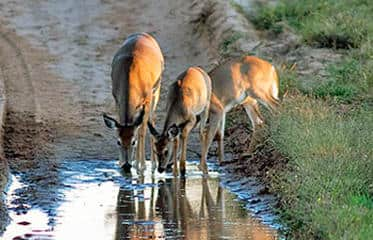2012 Report on Epizootic Hemorrhagic Disease Helps Clarify Extent of Kansas Outbreak

A total of 1,274 deer were suspected of having Epizootic Hemorrhagic Disease (EHD) in 2012, and although considered to be one of the worst outbreaks in the state, data suggests that this disease had “patchy” impacts on populations within deer management units (DMU).
Seventeen deer from 16 counties were diagnosed with EHD in 2012, with 16 of the deer being EHDV-2 positive and one deer being EHDV-1 positive. Symptomatic deer or dead deer found during the outbreak, indicative of EHD infection, were designated as suspects and counted, making the total count 1,274, including the ones that were tested.
To put Kansas EHD mortality rates into perspective, surrounding states reported the following figures for 2012: Illinois – 2,925; Iowa – 2,974; Nebraska – 5,998; Missouri – 10,177.
The 16 counties with confirmed cases of EHD-infected deer in 2012 included Anderson, Atchison, Coffey, Cowley, Dickinson, Doniphan, Douglas, Franklin, Jackson, Jefferson, Leavenworth, Lyon, Marshall, Osage, Republic, and Wilson.
Despite the high mortality rate associated with this disease, deer populations typically recover within a few years following EHD die-offs. The deer population in eastern Kansas continues to be robust and “gaps” left by EHD will quickly fill in with deer moving in from adjacent, less affected areas.
EHD was first detected in North America in the 1890s. Large scale regional deer population decreases have not been observed, but this disease can have a significant effect upon the deer in a localized area because of the high mortality rate associated with it.
EHD is an acute, infectious, viral disease transmitted from biting midges. EHD typically occurs in late summer and fall and is thought to be consistent with periods of biting midge abundance. Freezing temperatures usually greatly reduce these populations, bringing a sudden end to outbreaks, however active midge populations have been reported during winter in more mild climates.
Deer infected with EHD suffer from dehydration and high fever, causing them to seek water. Consequently, most deer that have fallen victim to this disease are found near the edges of rivers, ditches, and marshes.
There is no known effective treatment or control for EHD.
Other species commonly susceptible to this disease include mule deer, elk, and pronghorn.

